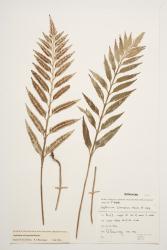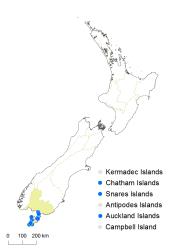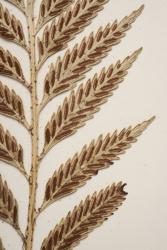- ≡ Asplenium lucidum var. scleroprium (Hombr.) T.Moore, Index Fil. 142 (1859)
- ≡ Asplenium obtusatum var. scleroprium (Hombr.) G.M.Thomson, Ferns New Zealand 74 (1882)
- = Asplenium flaccidum var. aucklandicum Hook.f., Bot. Antarct. Voy. I. (Fl. Antarct.) Part I, 109 (1844)
- ≡ Asplenium lucidum var. aucklandicum (Hook.f.) Allan, Fl. New Zealand 1, 1012 (1961)
- ≡ Asplenium aucklandicum (Hook.f.) Crookes, New Zealand Ferns ed. 6, 334 (1963)
Terrestrial or rupestral ferns. Rhizomes short, stout, erect, bearing scales. Rhizome scales ovate or narrowly ovate, 7–25 mm long, 1–4 mm wide, red-brown, clathrate. Fronds 170–1060 mm long. Stipes 75–460 mm long, pale or dark brown proximally and abaxially, green distally and adaxially, bearing narrowly ovate or narrowly triangular scales with short filiform apices. Rachises green, scaly. Laminae 1-pinnate, ovate or narrowly ovate or elliptic, abruptly narrowed to a short pinnatifid apical segment with serrate margins similar to the primary pinnae; laminae 95–640 mm long, 60–280 mm wide, dark green on both surfaces, thick and fleshy, bearing scales abaxially, lacking hairs. Primary pinnae in 5–25 pairs below a pinnatifid apical segment, not overlapping, all narrowly ovate or narrowly oblong; the longest in the proximal half of the lamina, 35–150 mm long, 8–35 mm wide; pinna apices acuminate, margins regularly and deeply serrate, bases cuneate and stalked. Sori reaching lamina margins at sinuses; indusia 4–12 mm long, straight; free margins of indusia entire. Mean spore size 48–53 μm long, 28–33 μm wide; perispores slightly winged but with few ridges.
Asplenium scleroprium is recognised by its thick fleshy fronds, 1-pinnate laminae, deeply serrate pinnae, and sori which extend to the margins at the sinuses. It is rather similar in appearance and occurs in the same habitat as A. obtusatum but is distinguished by its deeply serrate and acuminate pinnae, and sori that reach the margins at the sinuses.
South Island: Southland.
Chatham Islands, Stewart Island, Snares Islands, Auckland Islands.
Altitudinal range: 0–90 m.
Asplenium scleroprium is known only from Bluff and the New River Estuary, Invercargill, in the South Island, but has been recorded from many of the islands in Foveaux Strait, from the Snares and Auckland Islands, and from South-East Island in the Chatham Islands. It occurs near sea level in the South Island, but reaches 90 m on the Snares Islands.
Asplenium scleroprium occurs in Veronica elliptica coastal scrub at Bluff and on the Foveaux Strait islands, under Olearia lyallii on the Snares Islands, under Metrosideros umbellata on the Auckland Islands, and in rank flax-land on South-East Island. It grows either near the high-water mark or on coastal cliffs. At Invercargill, plants grow in disturbed vegetation of Podocarpus totara, Cupressus macrocarpa, under pines and willows, and on sandy soil at the water’s edge.
Asplenium scleroprium was given a conservation status of Naturally Uncommon by de Lange et al. (2013).
There is evidence that A. scleroprium hybridises with A. flaccidum subsp. flaccidum (Brownsey 1977a).
n = 144 (Brownsey 1977b).
Asplenium scleroprium Hombr. was treated as A. lucidum var. aucklandicum by Allan (1961). However, the combination A. lucidum var. aucklandicum (Hook.f.) Allan is incorrectly formed and cannot be used because the species name, A. lucidum G.Forst., is a later homonym of A. lucidum Burm.f. and therefore illegitimate (Brownsey 1979). Similarly, A. lucidum var. scleroprium (Hombr.) T.Moore is incorrectly formed and cannot be used.
On the basis of morphology, Asplenium scleroprium was previously suggested to be an allopolyploid derivative of a hybrid between Asplenium flaccidum subsp. flaccidum and A. obtusatum (Brownsey 1977a). However, analysis of low-copy nuclear DNA sequences suggests that A. scleroprium is an allopolyploid species derived from A. obtusatum and either A. chathamense, A. flaccidum subsp. flaccidum, or A. flaccidum subsp. haurakiense (Shepherd et al. 2008). The sequence analysis suggested that the latter was the most likely second parent, but this is anomalous given the non-overlapping distributions of present-day populations of the two putative parents. Further work is needed to determine the second parent. It is possible that this allopolyploid species has originated more than once on different island groups.






